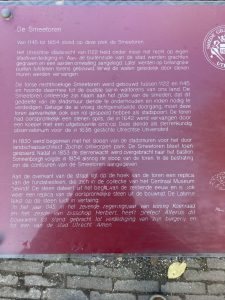The Smeetoren
From 1145 to 1854, the Smeetoren stood here.
The Utrecht city law of 1122 included, among other things, the right to own city defense. Canals were dug on the outside of the city and an earthen wall was constructed. Later, tuff towers were built at key points, while the ramparts were gradually replaced by stone walls.
The sturdy rectangular Smeetoren was built between 1122 and 1145, making it one of the oldest series of rampart towers in the Netherlands. The Smeetoren got its name from the guild of the blacksmiths, which had to maintain and, if necessary, defend this part of the city wall. The early bricked-up passage reveals that this tower must have also played a role as a city gate. The tower originally had a stone spire, which was replaced in 1642 by a dome with an extended tower. This served as an astronomical observatory for the Utrecht University, founded in 1636.
In 1830, the demolition of the city walls was started for the park designed by landscape architect Zocher. The Smeetoren was then spared. After the observatory was transferred to the bastion Sonnenborgh in 1853, the tower was demolished in 1854. The contours of the Smeettoren are indicated in the pavement.
Across the street, on the corner of the tower, is a replica of the foundation stone, which is part of the collection of the Centraal Museum. The stone dates from the early sixteenth century and is again a replica of the original stone from the construction period. The Latin text on the stone reads in translation:
In the year 1145, in the seventh year of King Conrad and the sixth of Bishop Herbert, Prefect Alferus built this structure to defend his citizenry to the honor of the city of Utrecht. Amen.

